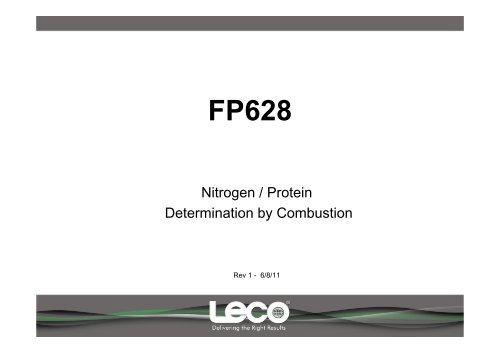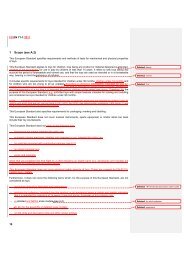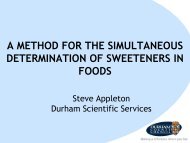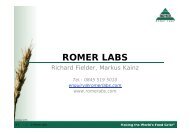Nitrogen / Protein Determination by Combustion
Nitrogen / Protein Determination by Combustion
Nitrogen / Protein Determination by Combustion
You also want an ePaper? Increase the reach of your titles
YUMPU automatically turns print PDFs into web optimized ePapers that Google loves.
FP628<br />
<strong>Nitrogen</strong> / <strong>Protein</strong><br />
<strong>Determination</strong> <strong>by</strong> <strong>Combustion</strong><br />
Rev 1 - 6/8/11
Presentation Outline<br />
• LECO Background<br />
• N <strong>Determination</strong><br />
• FP628<br />
– Theory of Operation<br />
– Specifications<br />
– Advantages<br />
– Software<br />
– Data
LECO Background<br />
• Privately owned U.S. Company for over 70 years<br />
• Headquartered in Saint Joseph, MI<br />
• Diverse Instrumentation offerings<br />
– Organic and Inorganic Elemental Analysis<br />
– Mass Spectrometry (TOF)<br />
– Metallography<br />
– Microscopy and Image analysis<br />
Environmental<br />
Food<br />
Energy<br />
Metals<br />
Mining<br />
• 25 LECO subsidiaries representing over 100 countries
N / <strong>Protein</strong> <strong>Determination</strong><br />
• Quantitative Analysis<br />
– Nutritional labeling (protein) for foods and feeds<br />
– Material characterization - education/research, commercial and regulatory<br />
– Soil/plant science<br />
• Process and Quality Control<br />
– Grade and value for feeds<br />
– Food, agricultural and chemical processing<br />
• Milling applications (starch, flour, oilseeds)<br />
• Chemical and Specialty materials processing (resins, adhesives, etc)
Techniques for Determining <strong>Nitrogen</strong>
FP628<br />
• Vertical quartz furnace tube with a maximum temperature of 1050°C<br />
• Sample mass 50mg up to ~1g<br />
• Tin capsules or foils used to encapsulate sample and attain high combustion<br />
temperature ~1800°C<br />
• Reticulated crucible collects ash from sample and tin cap or foil
FP628 Theory of Operation<br />
• A sample is weighed into a foil or capsule and loaded into autoloader
FP628 Theory of Operation<br />
• Sample is loaded into purge chamber<br />
removing atmospheric gas<br />
• Sample introduced to furnace
FP628 Series Theory of Operation<br />
• <strong>Combustion</strong> gases are swept from the<br />
furnace into the thermo electric cooler<br />
• Moisture efficiently removed without the<br />
use of chemical anhydrone
FP628 Theory of Operation<br />
• <strong>Combustion</strong> gas is swept onto the<br />
combustion gas collection and aliquot<br />
collection system
FP628 Theory of Operation<br />
• Aliquot gas is swept through a reduction reagent tube then passes through Lecosorb<br />
and anhydrone reagent tube
FP628 Theory of Operation<br />
• The aliquot gas passes through a thermal conductivity cell for nitrogen detection
Thermal conductivity table
FP628 Specifications<br />
• Instrument Range<br />
– <strong>Nitrogen</strong> 80ppm to 100% <strong>Nitrogen</strong> @ 500mg<br />
• Precision Range<br />
– <strong>Nitrogen</strong> 0.02 mg <strong>Nitrogen</strong> or 0.5% RSD (whichever is greater)<br />
• Analysis Time ~4.5 minutes nominal<br />
• Sample Mass<br />
– N up to ~1g, 500 mg nominal<br />
• Cost per Analysis<br />
– ~54p regardless of sample weight, type, moisture
FP628 Series Specifications (cont.)<br />
• Detection Technique<br />
– <strong>Nitrogen</strong> Thermal Conductivity (TC Cell) Detector<br />
• Furnace Resistance Primary and Secondary up to 1050 o C max<br />
• Autoloader 30-position, expandable up to 120<br />
• Electrical Power Requirements<br />
– Instrument 230 V~, 50/60 Hz, single phase, 12A
Instrument Range Concentration Calc<br />
• FP628 range:<br />
– 500 mg sample mass<br />
• <strong>Nitrogen</strong> (80ppm to 10%)<br />
– Low end = (0.04 mg N / 500 mg sample) * 100 = 0.08% or 80 ppm N<br />
– High end = (50 mg N / 500 mg sample) *100 = 10% N
FP628 Advantages<br />
• Analysis Time Throughput<br />
– Analysis time<br />
• FP628 is the fastest macro combustion instruments in the market<br />
• FP628 Series analysis time is ~4.5 minutes<br />
• Whole gas analysis techniques using chromatographic separation or purge<br />
and trap approached typically have 2 times longer analysis times<br />
• Competitive whole gas instruments analysis times are dependent on<br />
element configuration and sample mass (more elements and or sample<br />
mass = longer time…)<br />
Samples/Hour<br />
• FP628 Series 14<br />
• Competitor N model 7
FP628 Advantages<br />
• Low cost-per-analysis<br />
– Exclusive use of Oxygen within <strong>Combustion</strong> Furnace results in:<br />
• Ensures complete combustion and superior recovery of elements<br />
• Speeds combustion<br />
• Allows for use of macro sample mass<br />
• Eliminates the need for other reagent oxidizers within combustion system<br />
– Ballast and Aliquot <strong>Combustion</strong> Gas Handling system<br />
• Allows for the exclusive use of pure oxygen in the furnace<br />
• Eliminates treating the whole combustion gas with CO2 scrubbers and<br />
reduction reagents<br />
• Significantly extends lifetime of CO2 scrubber and reduction reagents
FP628 Advantages<br />
• Ability to determine carbon hydrogen and nitrogen in macro samples of various<br />
organic matrices under the same method and conditions<br />
• Multiple methods and calibrations are not required to compensate for poor<br />
combustion conditions<br />
• Allows system to analyze heterogeneous samples with better precision and accuracy<br />
– Plant Tissues<br />
– Feeds<br />
– Flour<br />
– Etc.
FP628 Series Software<br />
• LECO Windows ® -based operating software<br />
– Seamless management of data and<br />
detector plots<br />
– Integrated control charts and statistical<br />
calculations
FP628 Series Software<br />
• LECO Windows-based operating software<br />
– Monitor real-time internal component<br />
readings<br />
– Expanded interactive diagnostic<br />
screens aiding<br />
• Troubleshooting<br />
• Improve serviceability
FP628 Series Software<br />
• LECO Windows-based operating software<br />
– Simplified data handling with convenient storage and customizable reporting and<br />
data exporting capabilities<br />
– User definable fields for automatic calculations<br />
– Compatible with various Laboratory Information Management Systems (LIMS)
FP628 Calibration<br />
Wide Dynamic Range Calibration<br />
– ~50 mg to ~350 mg EDTA<br />
• 1.0 to 33.5 mg N<br />
• Linear curve type
CN628 Blanks<br />
• Low Consistent Blank<br />
– ~3 ppm <strong>Nitrogen</strong> Std Dev
FP628 Data<br />
502-563 Corn Flour Sample Data<br />
– ~250 mg sample mass<br />
– EDTA Calibration<br />
– Cert values:<br />
• 1.46 +/- 0.02 % N
FP628 Data<br />
502-563 Corn Flour Sample Data<br />
– ~250 mg sample mass<br />
– EDTA Calibration<br />
– Cert values:<br />
• 1.46 +/- 0.02 % N
FP628 Data<br />
Glycine Solution Sample Data<br />
– ~300 mg sample mass<br />
– EDTA Calibration<br />
– Expected value:<br />
• 0.1 % N
FP628 Data<br />
Ammonium Sulfate Sample Data<br />
– ~50 mg sample mass<br />
– EDTA Calibration<br />
– Theoretical value:<br />
• 21.2 % N
CHN628 Series<br />
Elemental Analysis <strong>by</strong> <strong>Combustion</strong><br />
Unparalleled Capabilities
Leco Macro <strong>Nitrogen</strong> <strong>Determination</strong><br />
• Vertical and horizontal furnace designs utilize the LECO combustion approach resulting in:<br />
− Rapid analysis time (4 minutes)<br />
− Extended reagent lifetimes and instrument uptime<br />
− Ability to handle macro samples up to ~3g<br />
− Low cost-per-analysis<br />
− Complies with AOAC, ASTM, ISO, AACC AND ASBC approved methods
Leco Instruments UK Ltd<br />
Thanks for Listening<br />
Michael Reaney<br />
If you require further information please feel free to contact the Leco stand








